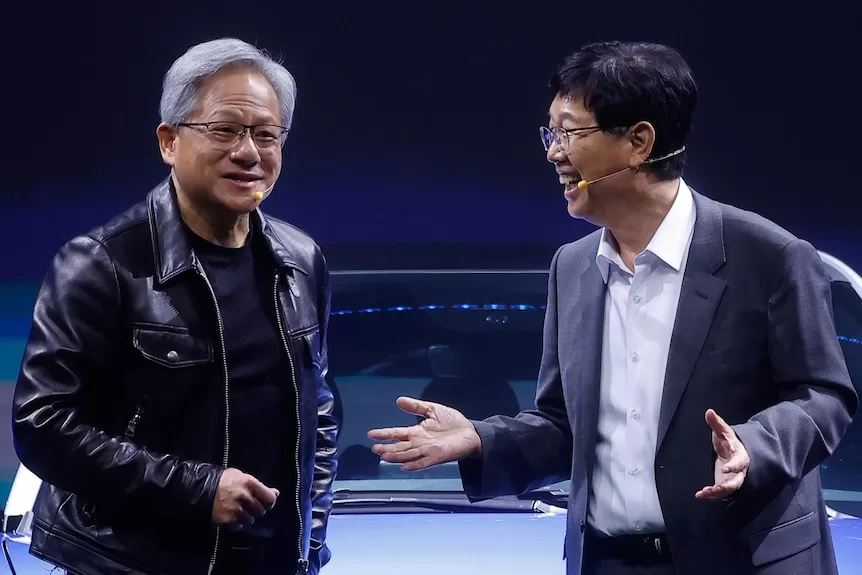- In short: Chipmaker Nvidia has posted a record revenue figure of $US22.1 billion for the December quarter — up 265 per cent on the prior year.
- Its share price closed up 16.4 per cent, giving the company a market value of $US1.94 trillion — about $US25 billion higher than Australia’s GDP.
- What’s next? Analysts are bullish about Nvidia’s future given AI is in its infancy — but supply-chain and geopolitical issues could still arise.
If you’ve noticed a little green sticker on your PC or laptop, it likely means Nvidia’s computer hardware — or graphics card, for the tech-minded — is inside.
“Nvidia started off by making the chips that go into your PC that allow you to play games really fast,” says Mark Pesce, an honorary associate in digital cultures at the University of Sydney.
“So if you’re running Fortnite at, say, 30 or 50 frames a second, then it’s probably because you have an Nvidia chip in your PC making that happen.”
Nvidia opened its doors for business in 1993.
The power of its hardware makes artificial intelligence (AI) applications developed by Tesla, Facebook, Amazon, Google and Microsoft possible — which means it is now in enormous demand.
“They make the best chips for gamers, and they have for a long time,” Dr Pesce says.
“But a few years ago they realised that the chips for gamers were also really good at AI.”
On Thursday, the tech giant posted revenue of $US22.1 billion ($33.6 billion) for the December quarter of 2023 — up 265 per cent on the prior year.
Loading…
The news had investors piling into the stock, increasing its market valuation by $US250 billion ($381 billion).
That’s the biggest one-day gain by any company in Wall Street history.
“The world has reached a tipping point of new computing power,” Nvidia’s chief financial officer, Colette Kress, said at the results announcement.
Shares in Nvidia closed up 16.4 per cent higher on Wall Street, at $US785.38.
That surge gives the tech giant a market valuation of $US1.94 trillion ($2.95 trillion), about $38 billion larger than Australia’s gross domestic product.
“They not only smashed their profit — and there were a lot of analysts that were saying it’s impossible for Nvidia to even make their projected profits this term — they smashed them by 700 per cent,” Dr Pesce says.
“There is such demand for the chips they’re making, and they’re in such short supply — and they are making those chips as fast as they can right now — that they are literally printing money on silicon.”
AI boom driving market growth
The key to Nvidia’s recent success is the explosion in demand for Microsoft-linked products like ChatGPT that use its chips.
But can that demand be sustained, especially when many of the big tech giants are looking to make their own chips with the same computing power?
Dr Pesce believes it can.
“Nvidia will not have the market entirely to itself, but the market is growing so fast that that probably doesn’t matter,” he says.
“AI has got a long way to run. You’re not seeing people spending money with no promise of return.”
Loading…
He says right now investments in AI are paying off handsomely mostly because that money is going into infrastructure.
“We are in a ‘picks and shovels’ phase — and so as long as that holds out, investor returns will be good,” he says.
“But it’s as we hit the applications of AI — how is it going to change the way you’re working, or I’m working, day to day? — that’s where we’re going to see whether the fortunes are real or not.”
Independent analyst Evan Lucas is “excited” about Nvidia’s earnings prospects, and has dismissed suggestions of a financial markets “bubble”.
“There is no sign of stress in Nvidia to suggest there is a bubble,” he says.
“This is not a new company; Nvidia’s been around for three decades. So it has history, it understands what it does.
“There is also experience, there’s the right people in place. It is now a mature company that is going to another level.”
But Mr Lucas does have some concerns about the company’s outlook.
“My concern would be that [if you had] a supply interruption [like the one] that COVID created, that you’d have an interruption where maybe the chip technology started to fail,” he says.
“If the chip technology was to fail and wasn’t able to deal with the processing requirements AI needs, that would be an individual structural problem that Nvidia would suffer from.”
Nvidia also faces geopolitical risks, Dr Pesce points out, given its production facilities are based in Taiwan.
